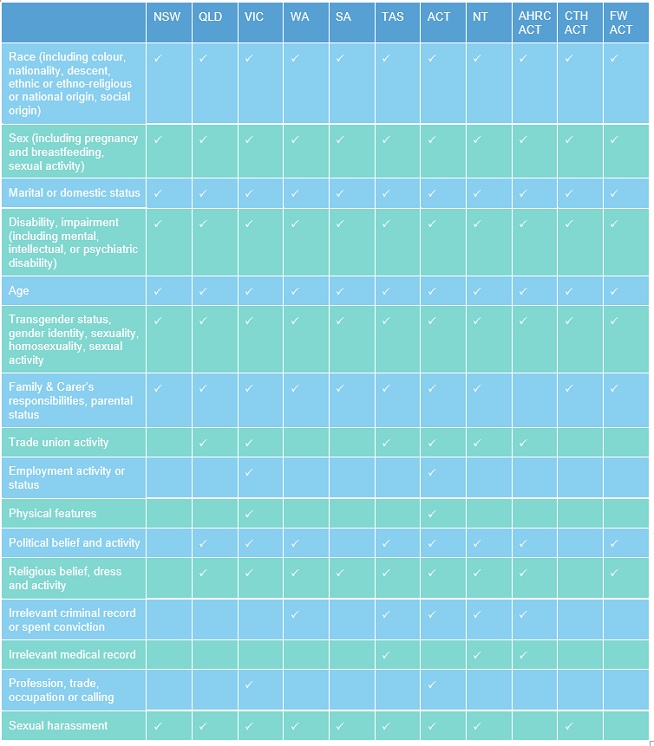Discrimination is a constantly evolving area of Australian law. The protected grounds of discrimination, especially those in state and territory anti-discrimination legislation, are continuously changing and reshaping, with some being included as recently as this year.
Employers need to be aware of all of the grounds of discrimination applicable in their state to ensure they do not inadvertently discriminate against an employee. This is particularly challenging for multi-state employers who need to comply with a matrix of state and territory anti-discrimination legislation.
The traditional grounds
In Australia, there are four main federal anti-discrimination laws that protect against discrimination on the grounds of race, sex, age and disability. Under each of these grounds, there are a number of sub-categories of protected grounds. For example, the Racial Discrimination Act 1975 also contains grounds relating to colour, nationality, descent, ethnic, ethno-religious, national origin, and social origin discrimination. Similarly, the Sex Discrimination Act 1984 contains a number of additional grounds, including pregnancy, breastfeeding, sexual activity, marital or domestic status, transgender status, gender identity, sexuality, family and carer's responsibility discrimination.
Employees who suffer discrimination on the basis of these grounds can make a complaint to the Australian Human Rights Commission (the "AHRC"), where the complaint is conciliated. If conciliation fails, the employee can litigate their complaint in the Federal Court or Federal Circuit and Family Court of Australia.
Additional protected grounds
The Australian Human Rights Commission Act 1986 ("AHRC Act") provides for additional protected attributes at a federal level, including irrelevant medical record, irrelevant criminal record, political belief, religious belief and trade union activity.
While these grounds are not protected by the four federal anti-discrimination laws, the AHRC has the power to investigate and, where appropriate, try to resolve a complaint of discrimination by conciliation. However, if the conciliation fails the complaint cannot be litigated by an employee in any Court. The AHRC's actions are limited to preparing a report with recommendations to the Attorney-General, for tabling in the Federal Parliament.
Nevertheless, employers should be aware of these additional protected grounds, to avoid the cost of attending conciliation conferences at the AHRC as well as the reputational damage caused by a complaint.
The lesser-known grounds
In addition to the federal protections against discrimination, each Australian state and territory has its own anti-discrimination legislation that covers some or all of the above grounds, and some additional protected grounds. Many employers would not be aware of the expansive list of additional grounds of discrimination contained in state and territory legislation. The table below provides an overview of the protected grounds at a federal, state and territory level.
It may come as a surprise to some employers that grounds of discrimination include protection against physical features, profession, trade, occupation or calling and employment activity or employment status discrimination. While these are not protected grounds in all states and territories, and are only protected grounds in Victoria and the Australian Capital Territory, anti-discrimination is a constantly evolving area of law and other states and territories may follow.
If an employer has discriminated against an employee on the basis of state or territory legislation, the employee can complain to their state or territory anti-discrimination body. Generally, the employer and employee will then have an opportunity to resolve their complaint through a conciliation process. If conciliation fails, an employee can then litigate their complaint in their state's Civil and Administrative Tribunal.
Snapshot of the protected grounds
The table below summarises the protected grounds of discrimination under state, territory and federal legislation.

NSW: Anti-Discrimination Act 1977
QLD: Anti-Discrimination Act 1991
VIC: Equal Opportunity Act 2010
WA: Equal Opportunity Act 1984
SA: Equal Opportunity Act 1984
TAS: Anti-Discrimination Act 1998
ACT: Discrimination Act 1991
NT: Anti-Discrimination Act 1996
AHRC Act: Australian Human Rights and Commission Act 1986

